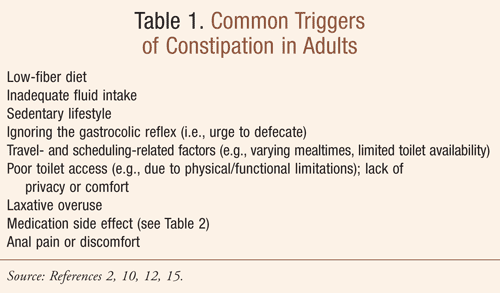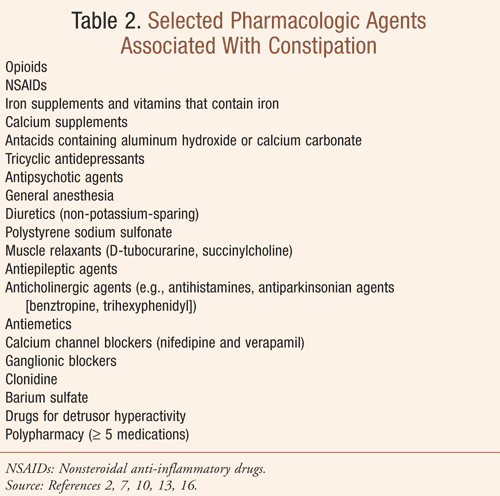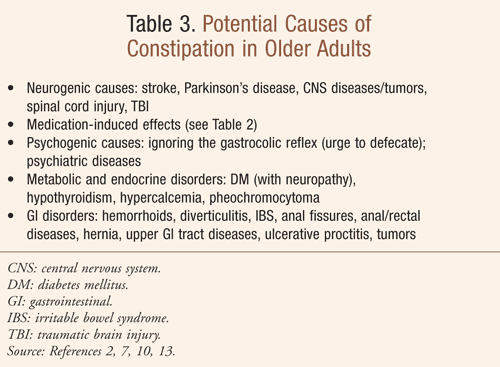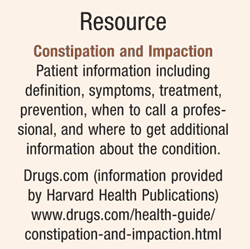US Pharm. 2012;37(1):21-24
The exquisite neuropathic pain of shingles; the debilitating pain of sciatica; the unrelenting pain of osteoarthritis—all these conditions can cause moderate to severe pain requiring intervention with an opioid, and almost all older patients who take opioids become constipated.1 Left untreated, constipation, particularly in seniors and the bedridden, can lead to fecal impaction (FI)—a hardened solid mass of feces causing pain and vomiting.2 Overflow paradoxical diarrhea may also occur, presenting as watery mucus and fecal material, which passes around the impacted mass, accompanied by cramping.3 FI usually requires enemas and/or manual fragmentation and disimpaction with intrarectal local anesthetics (e.g., lidocaine 5% ointment or dibucaine 1% ointment).3 Further, FI can obstruct the bowel, and if not rapidly treated, may result in inadequate blood flow to the bowel (bowel ischemia) and bowel perforation requiring emergency treatment and hospitalization.4
This article is not an overview of opioids, nor is it an overview of constipation, but rather a call to arms for pharmacists to anticipate and prevent the most predictable adverse effect of opioids in seniors—constipation. Raising awareness of this issue is not enough, especially since clinicians can have a dismissive attitude about constipation and may not consider the problem seriously. It requires an attempt to mobilize a course of action for all pharmacists to educate and intervene when an opioid is initiated—to instruct and guide the older adult patient who begins to receive or is receiving opioids (and his or her caregiver) to anticipate the adverse effect of constipation and appropriately manage and/or prevent it. The action required is preemptive treatment of constipation; that is, all patients commenced upon opioids should be coprescribed laxatives.5,6 Unless contraindicated, an appropriate combination to use is a stimulant laxative (e.g., senna) and stool softener (e.g., docusate).6 Note that high fiber products exacerbate constipation if used with inadequate fluid intake; stimulants should be avoided in patients with known colonic lesions; and lactulose in high doses (60-90 mL/day) can produce excessive flatus.6
Why is the issue of preemptive treatment of constipation when commencing treatment with opioids so significant? The increased risk of fecal impaction as a complication of constipation in longterm care residents (occurring in about 30%) may precipitate acute hospital admissions.2,7 Opioid-associated FI can occur in ambulatory seniors, as well. At least 5% of hospital admissions for the elderly are attributed to adverse drug effects (ADEs).8 An emergency department (ED) visit may create more stress for an elderly patient; polypharmacy and ADEs may affect a senior’s presentation, rendering it less apparent; and many elderly patients are hospitalized after they are evaluated in the ED.8 When patients are transferred to or from a hospital, medications are likely to be added or changed, leading to an increased risk of ADEs.
All health care professionals should bear in mind that hospitalization appears to be associated with poorer outcomes with increasing age (i.e., physiological age is a more important predictor than is chronological age).8 About 75% of patients aged 75 years and older who are functionally independent at admission are not functionally independent when they are discharged (15% of patients aged 75 years or older are discharged to skilled nursing facilities); subacute care and rehabilitation in a skilled nursing facility subsequent to an abbreviated acute hospital stay may explain why these percentages are high.8 However, even when a disorder is treatable or appears uncomplicated, patients may not return to prehospital functional status.8
As previously mentioned, constipation is the most frequently reported ADE associated with the chronic use of opioids, and almost all older patients who take opioids become constipated.1,9 Further, unlike other opioid-induced adverse effects, tolerance to constipation does not develop.9 Opioids have effects on every segment of the bowel; however, the most pronounced effect is on the colon.10 It has been proposed that the major mechanism by which these agents produce constipation is the prolongation of intestinal transit time by causing spastic, nonpropulsive contractions. This intestinal inhibitory effect appears to be more pronounced with orally administered opioids than with parenterally administered preparations.10 Interestingly, adults older than 60 years have higher plasma concentrations of beta-endorphin with increased binding to opiate receptors in the wall of the gut and myenteric plexus.7
Normal frequency of bowel movements varies from person to person, with approximately 95% of healthy adults having a pattern of defecation ranging from three times a day to three times a week.2 Constipation, the difficult or infrequent passage of stool, hardness of stool, or feeling of incomplete evacuation, affects approximately one-third of elderly women and one-quarter of elderly men.3,11 Constipation is such a common problem that it affects at least 80% of people at some time during their lives and has been related to a diminished perception of quality of life.2,11 Further, it is one of the most frequent reasons for self-medication, with at least $800 million spent annually for laxatives.2,12 In the United States alone, treatment for constipation accounts for more than 2.5 million doctor visits annually.2 While an adult of any age can suffer from constipation, risk increases dramatically after age 65 in both men and women.2
Most often, constipation is not directly related to an illness or gastrointestinal disorder, but rather is associated with diet, lifestyle, medications (Table 1 and Table 2) or some other factor that causes hard stool or interference with the stool’s ability to pass comfortably.2


However, there are potential diseases and conditions, seen more frequently in older adults, that may cause constipation (Table 3). Interestingly, constipation is more prevalent in individuals with nonulcer dyspepsia, as these two conditions are both associated with gastrointestinal hypomotility.7 Patients with diabetes-associated autonomic neuropathy are more likely to be constipated secondary to a markedly slowed transit throughout the colon and impairment of the gastrocolic reflex (urge to defecate).7 Parkinson’s patients suffer from degeneration of dopaminergic neurons in the myenteric plexus resulting in prolonged colorectal transit, among other pathologies that lead to constipation.7 Sixty percent of recovering stroke patients in rehabilitation wards are affected by constipation, and those residing in the community have difficulty with toilet access secondary to functional impairment.7

Opioids for Persistent Pain in Older Adults
Clinicians are often reluctant to prescribe opioids for elderly patients with persistent pain, previously referred to as chronic pain, typically because of concerns about adverse drug effects (e.g., sedation, constipation, delirium) and the development of dependence (even though it is uncommon in elderly people).5,13 When opioids are prescribed for older adults, the doses are often inadequate; underprescribing may mean that some seniors are experiencing needless pain and discomfort. Further, it has been shown that elderly adults are more likely to report inadequate pain management compared with their younger counterparts.13
Commonly affecting older adults, persistent pain is most frequently associated with musculoskeletal disorders such as degenerative spine conditions and arthritis.14 Based on high-quality effectiveness and safety evidence, acetaminophen should be considered as initial and ongoing pharmacotherapy in the management of persistent pain, particularly musculoskeletal pain.14 According to the American Geriatrics Society Panel on the Pharmacological Management of Persistent Pain in Older Adults, all patients with moderate to severe pain, pain-related functional impairment, or diminished quality of life due to pain should be considered for opioid therapy.14 For specific recommendations regarding the use of opioids (and nonopioids, adjuvant analgesics, and other drugs) in older adults with persistent pain, consult Reference 14. The AGS panel further guides clinicians by indicating the need to anticipate, assess for, and identify potential opioid-associated adverse effects.
Anticipating constipation as a very likely ADE when a senior is initiated on an opioid and discussing a course of action are not only an integral part of management of opioid therapy, but also an essential component of dispensing an opioid. In essence, it is an opportunity for all pharmacists, regardless of the practice setting, to become involved, whether it be the community pharmacist counseling a patient, the consultant pharmacist making a recommendation, or the health systems pharmacist educating nurses to prompt the prescriber when opioids are initiated in the inpatient setting. When constipation is managed appropriately, fecal impaction and its complications can be prevented.15
Prevention of Constipation: Lifestyle Factors
To prevent constipation, patients and caregivers should be encouraged to work toward lifestyle changes including adequate dietary fiber, adequate fluid intake, and adequate exercise.12 While approximately 25-30 g of fiber daily is required to soften the stool and encourage proper bowel function, most American diets consist of less than half that amount.2 At least six to eight servings of water (including full glasses of milk, juice, and other beverages) are required to help prevent stools from becoming dry and hard; water content in fruits, soups, stews, and solid foods may also be counted.2 In order to promote normal muscle contractions in the bowel wall, regular exercise is necessary; there is a high risk of constipation among those who rarely exercise or have a sedentary job.2 These lifestyle measures should be tailored to and tolerated by the individual based on current health considerations and comorbidities.
Optimally—and when possible—defecation should take place in a private and unrushed atmosphere.15 Further, patients and caregivers should be made aware of the advantage of paying attention to the gastrocolic reflex that occurs a few minutes after consuming food and assists with passing stool easily.15 If this normal nerve reflex is ignored repeatedly (e.g., due to limited access to restrooms), it may lead to constipation. Individuals who travel may encounter constipation secondary to a change in diet, varying mealtimes, and limited access to restrooms.
An online resource that may also serve as a printable handout is available for patients and caregivers as a guide to recognizing, treating, and preventing constipation and understanding when to seek professional help (see Resource).

Conclusion
While constipation is a common health concern for older adults in all health care settings, the preemptive treatment of constipation when initiating opioid therapy can help avoid fecal impaction and the potential complications that may require emergency treatment or hospitalization, which in turn may place seniors at risk for functional impairment. In this vein, pharmacists should not overlook the opportunity to intervene with every initiation of opioid therapy in seniors through education, guidance, and recommendations for the prevention and management of constipation in these vulnerable patients.
REFERENCES
1. Beers MH, Jones TV, Berkwits M, et al, eds. The Merck Manual of Health & Aging. Whitehouse Station, NJ: Merck Research Laboratories; 2004: 129,189,293,679,692,749-755,
2. Constipation and impaction. Drugs.com. Information provided by Harvard Health Publications.
www.drugs.com/health-guide/
3. Constipation. Chapter: Approach to the patient with GI complaints. Section: Gastrointestinal disorders. MerckManuals.com. Revised October 2007.
www.merckmanuals.com/
4. Intestinal obstruction. MDGuidelines.com.
www.mdguidelines.com/
5. Bruckenthal P. Pain in the older adult. In: Fillit HM, Rockwood K, Woodhouse K, eds. Brocklehurst’s Textbook of Geriatric Medicine and Gerontology. 7th ed. Philadelphia, PA: Saunders Elsevier; 2010:965-972.
6. Finlay I, Capel M. Palliative medicine for the elderly patient. In: Fillit HM, Rockwood K, Woodhouse K, eds. Brocklehurst’s Textbook of Geriatric Medicine and Gerontology. 7th ed. Philadelphia, PA: Saunders Elsevier; 2010:973-982.
7. Harari D. Constipation. In: Halter JB, Ouslander JG, Tinetti ME, et al, eds. Hazzard’s Geriatric Medicine and Gerontology. 6th ed. New York, NY: McGraw-Hill; 2009:1103-1122.
8. Hospital care and the elderly. Chapter: Provision of care to the elderly. Section: Geriatrics. MerckManuals.com. Revised June 2009.
www.merckmanuals.com/
9. Cherny NI. The management of cancer pain. CA Cancer J Clin. 2000;50:70-116.
10. Spruill WJ, Wade WE. Diarrhea, constipation, and irritable bowel syndrome. In: DiPiro JT, Talbert RL, Yee GC, et al, eds. Pharmacotherapy: A Pathophysiologic Approach. 7th ed. New York, NY: McGraw-Hill Inc; 2008:617-632.
11. Schaefer DC, Cheskin LJ. Constipation in the elderly. Am Fam Physician. 1998;58(4):907-915.
12. Kissinger JF, Jefferson KW, Jung SA. Gastrointestinal disorders. In: Youngkin EQ, Sawin KJ, Kissinger JF, et al. Pharmacotherapeutics: A Primary Care Guide. Upper Saddle River, NJ: Pearson Prentice Hall; 2005:461-488.
13. Drug-related problems in the elderly. Topic: Drug therapy in the elderly. Section: Geriatrics. MerckManuals.com Revised September 2009.
www.merckmanuals.com/
14. Pharmacological management of persistent pain in older adults. American Geriatrics Society Panel. JAGS. 2009:57:1331-1346.
15. Kane RL, Ouslander JG, Abrass IB. Essentials of Clinical Geriatrics. 5th ed. New York, NY: McGraw-Hill, Inc; 2004:212-215.
16. Harvey RA, Champe PC. Pharmacology. 4th ed. Philadelphia, PA: Lippincott Williams & Wilkins; 2009:159-170.
To comment on this article, contact rdavidson@uspharmacist.com






